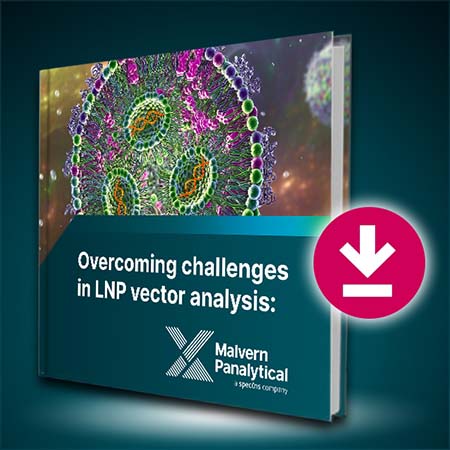為什麼您需要測量mRNA-LNP表面電荷(以及如何進行測量)

在之前的博客中,我們探討了(以及測量技術)脂質納米顆粒(LNP)的尺寸的重要性。現在,我們將注意力轉向表面電荷,為您提供專家見解,說明為什麼以及如何最好地測量它。
表面電荷:LNPs的關鍵測量
近年來,人們對LNPs的興趣激增。而這不難理解——這些微小的載體有可能針對一些最具挑戰性的醫療狀況,並且可以在其他藥物遞送載體通常無法達到的規模上進行生產。
開發和製造基於LNP的療法和疫苗仍然是一個巨大的挑戰。由於LNP非常複雜,分析表徵極其困難——很難知道要測量哪些屬性,以及哪些分析工具將幫助解答您的問題。
深入了解表面電荷測量
那麼,表面電荷到底是怎麼回事呢?為什麼要測量它?它能告訴您什麼?
表面電荷——又稱為zeta電位——是在LNP開發中測量的重要屬性。它不僅能夠洞察您的療法在體內的命運和活動(表面電荷可能是溶解度和細胞膜相互作用的最重要決定因素),還能夠為您提供有關LNPs表面化學的信息(以及在開發和生產過程中可能發生的任何修改)。
ELS——測量表面電荷的首選工具

電泳光散射(ELS)是測量您的LNP在特定介質中獲得的電荷的首選技術。
ELS是一種基於電泳原理的簡單技術。LNP溶液被引入到含有兩個電極的細胞中(見圖1),在其間施加電場,帶電顆粒(在此情況下為LNPs)以與其zeta電位相關的速度向電荷相反的電極遷移。
雷射穿過細胞底部,帶電顆粒散射光。由於散射光的頻率根據顆粒的速度發生偏移,以這種方式測量速度使分析人員能夠計算zeta電位。
通常,ELS被用來探索在磷酸鹽緩衝鹽水(PBS)或樣品的10倍稀釋版本中的LNP表面電荷測量,由此分析人員能夠驗證LNP的表觀表面電荷的真實性或評估不同LNP配方的穩定性和預期攝取效率。(當然,應用ELS來表徵LNPs還有許多其他好的理由,您可以在電子書中發現。)
獲得最佳表面電荷測量
重要的是,許多因素可能影響顆粒的zeta電位,包括:
- pH值的變化
- 離子強度
- 溶液中其他成分的濃度
為了確保zeta電位測量的可再現性,至關重要的是您報告用於測量的樣品緩衝液,以及zeta電位值的對應導電率。
克服一個關鍵挑戰
即使您在zeta電位測量中考慮到上述建議,您仍可能受到zeta電位檢測中最大挑戰之一的影響:高導電性樣品。

想進一步了解這一挑戰以及如何最好地克服它以確保最準確的表面電荷測量?那麼查看我們的內容豐富的電子書,“克服LNP載體分析中的挑戰:關鍵工具、技術和考量”,由我們的分析專家編寫。
在其中,我們涵蓋了您需要知道的一切,以便更自信地表徵您的LNPs,幫助您
- 獲得更深入的見解
- 最小化樣品使用
- 節省時間
- 並降低成本。
這篇文章可能已自動翻譯
{{ product.product_name }}
{{ product.product_strapline }}
{{ product.product_lede }}
